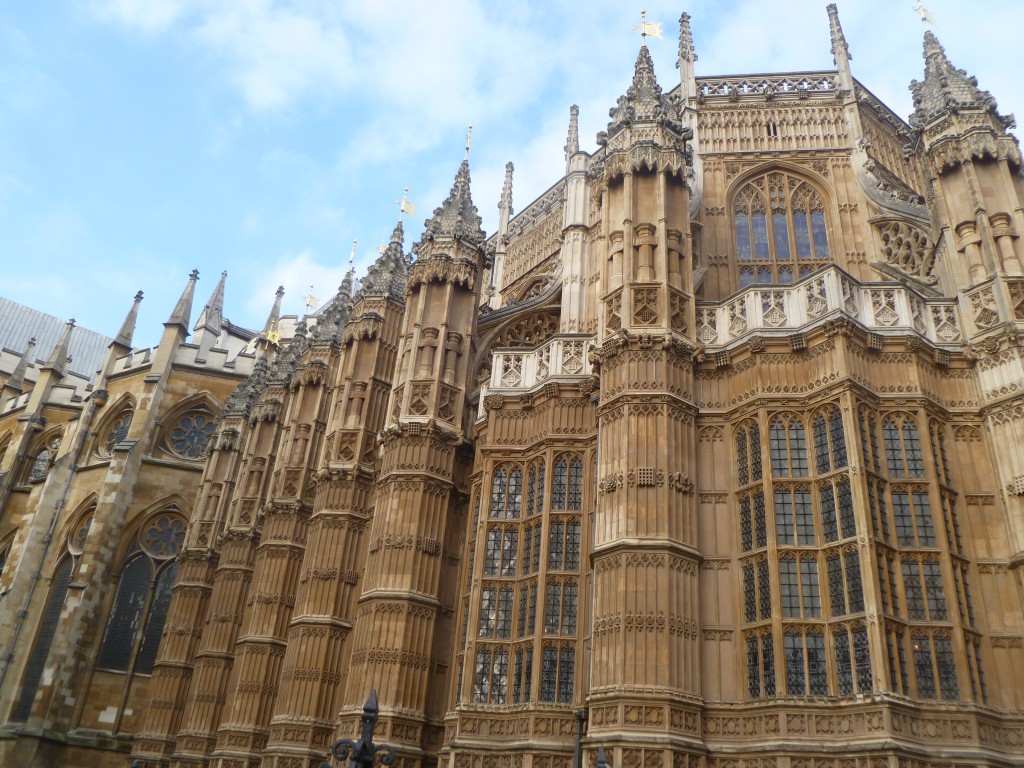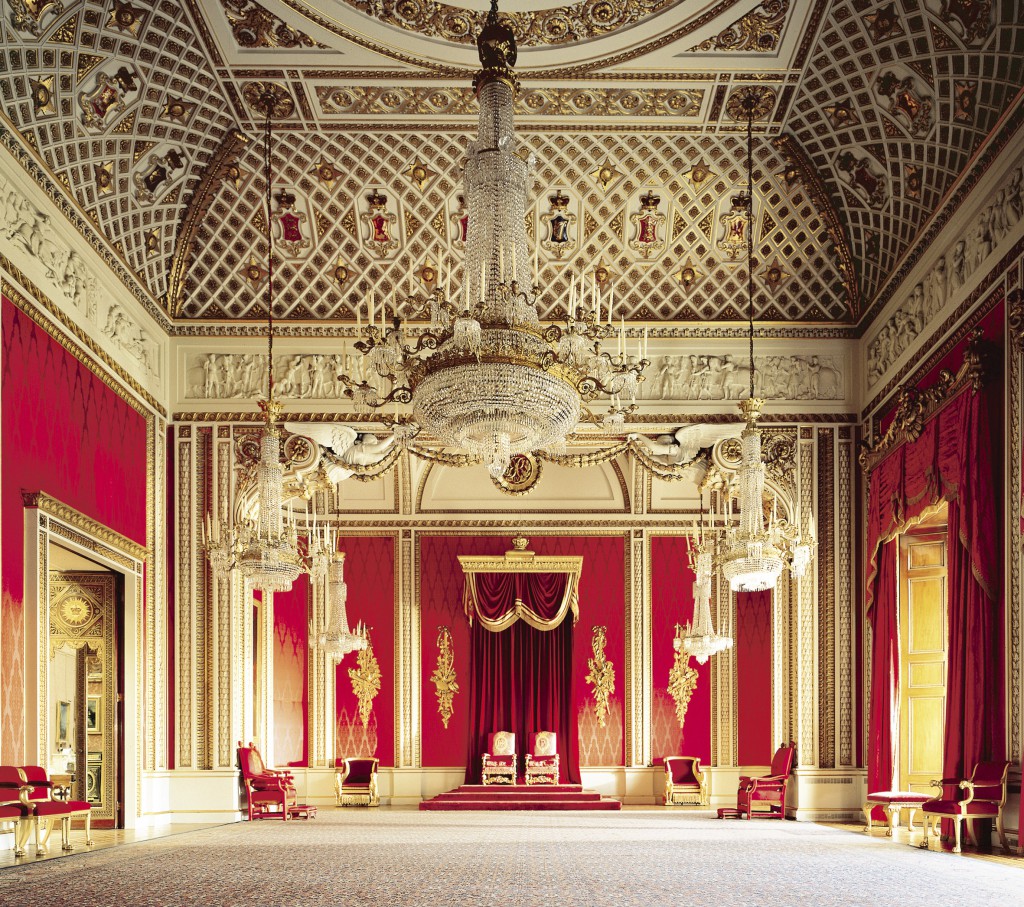Day 5 in England- Westminster Abbey, Late Turner, and Buckingham Palace
As my classmates and I set out from our hotel on the morning of Thursday, January 22, we knew we were in for a day filled with beautiful objects, architecture, and art. We started off with a trip to Westminster Abbey.
 Westminster Abbey cuts an imposing figure in the morning light.
Westminster Abbey cuts an imposing figure in the morning light.
At the Abbey, we listened to audioguides narrated by Jeremy Irons and toured at our own pace. Westminster Abbey has a storied history which stretches from 1245, when Henry III began construction upon the present structure. Perhaps the most memorable features are the tombs and monuments covering the floor, walls, and alcoves of the Abbey.
 The exterior of Westminster Abbey – no pictures allowed inside!
The exterior of Westminster Abbey – no pictures allowed inside!
The individuals memorialized throughout the Abbey are a veritable who’s who of English history, including renowned British monarchs, politicians, soldiers, scientists, and artists. There seems to be a degree of politicization in the placement of these monuments, particularly in how the monuments are displayed to visitors today. The memorial of Robert Adam, for example, which was very exciting to members of our group but perhaps a little less so for the ordinary visitor to the Abbey, was covered under chairs set aside for visitors. Unfortunately, our jam-packed schedule for the day did not allow us to linger at the Abbey and I enjoyed a quick walk through the cloisters before meeting up with our group outside.
 Bell towers of Westminster Abbey as seen from the Cloisters
Bell towers of Westminster Abbey as seen from the Cloisters
Our group gathered and headed to our next destination, the Tate Britain, via a scenic walk that took us past the back of Westminster Abbey and the Houses of Parliament.
 Members of the group caught mid-stroll outside of the Houses of Parliament on the way to the Tate Britain!
Members of the group caught mid-stroll outside of the Houses of Parliament on the way to the Tate Britain!
When we arrived at the Tate, we saw the Late Turner exhibit. Many of us had prepared to see this exhibit by going as a class to see the film Mr. Turner. While there was a rather mixed consensus on the film’s various merits, we all felt as though we learned much more about the end of Turner’s life. This background knowledge added much to our understanding of Turner’s works.
The extensive exhibit included a wide range of Turner’s late work, including oil paintings of every shape and size and watercolors from many of his travels. The thematic rooms expressed the shifting approaches and subjects Turner used near the end of his life. Following our visit to the exhibit, we had some time to explore the other galleries of the Tate individually and eat lunch. After our meals, we gathered outside and headed out to walk to our next destination – Buckingham Palace!
 When we saw this intersection, we knew we were headed in the right direction.
When we saw this intersection, we knew we were headed in the right direction.
Buckingham Palace was probably the destination I was the most excited about visiting in London. As a child, I had a beloved VHS tape that contained a documentary about Buckingham Palace that I would watch over and over and over. I was thrilled to have a chance to see the rooms I had watched on a screen so many times in person! After giving our credentials and passing through security, we met up with Lucy Peter, who did a lovely job organizing our visit, and Desmond Shawe-Taylor, the Surveyor of the Queen’s Paintings, who lead our tour through the palace.
 The perfect British tableau: My Buckingham Palace VHS, a McVities Digestive Biscuit, and me.
The perfect British tableau: My Buckingham Palace VHS, a McVities Digestive Biscuit, and me.
Our visit took us through the State Rooms of the Palace, which are used by the Royal Family today to greet and receive dignitaries and guests. The State Rooms comprise a suite of rooms of varying size, decoration, and degrees of intimacy. Many of the state rooms are furnished and decorated with objects and works of art purchased by King George IV, though each monarch who has subsequently inhabited the Palace has left their own mark on the spaces. Queen Victoria,for example, used portraits and other works of art in the Grand Staircase to reinforce her dynastic claim to the throne.
 The Buckingham Palace Grand Staircase as represented in an illustration from The Graphic in 1870. (Courtesy of Wikimedia Commons)
The Buckingham Palace Grand Staircase as represented in an illustration from The Graphic in 1870. (Courtesy of Wikimedia Commons)
The State Rooms were filled with countless pieces of stunning furniture, porcelain, and works of art. Some of the items which particularly stood out to our group were several pieces of French case furniture whose fronts were inlaid with precious Italian stonework, the thrones used by monarchs from George IV to Elizabeth II, some examples of Sèvres porcelain, and a Vermeer painting in the picture gallery.
 Buckingham Palace Throne Room. (Royal Collection, courtesy of royal.gov.uk, Photo by Derry Moore © 2009)
Buckingham Palace Throne Room. (Royal Collection, courtesy of royal.gov.uk, Photo by Derry Moore © 2009)
During our visit, the State Rooms were being set up for a fundraising dinner to be held that evening. The picture gallery was filled with ornately laid tables, upon which were centerpieces showcasing pieces from the Rockingham Service and other royal dinner services. While we admired the pictures and porcelain in the Picture Gallery, we could hear an orchestra and singer rehearsing The Marriage of Figaro in the ballroom next door. The music continued to waft through the halls as we continued our visit through the State Dining Room, Blue Drawing Room, Music Room, and finally the magnificent White Drawing Room. Each room we passed through was more opulent and lovely than the last, and Desmond Shawe-Taylor continued to offer thoughtful and incisive commentary tailored to our groups’ interests throughout the Palace. While the richly decorated interiors, furniture, and artwork were not the preferred style of everyone in our group, I think we all left Buckingham Palace amazed by the pieces we had seen and rather in awe at the grandeur of the Palace itself. The experience of visiting a current royal residence and seeing it bustle in preparation for a formal function offered an interesting contrast to our visit to Hampton Court the day before.
 English Design History 2015 in front of Buckingham Palace!
English Design History 2015 in front of Buckingham Palace!
After we left Buckingham Palace, we gathered outside for a group picture, and then headed on our separate ways for dinner and evening activities. I ended up attending a chamber music concert with Amy and Hannah at St. Martin-in-the-Fields, where we heard beautifully played excerpts from Mozart and a range of other classical and modern composers.
 Hannah and Amy emanating a post-concert glow at St. Martin-in-the-Fields
Hannah and Amy emanating a post-concert glow at St. Martin-in-the-Fields
By Rosalie Hooper, WPAMC class of 2016


Leave a Reply